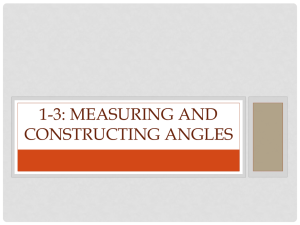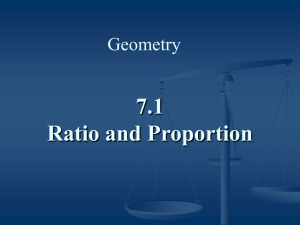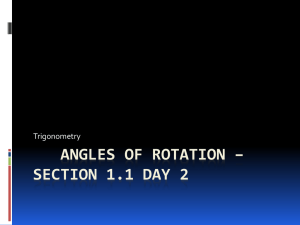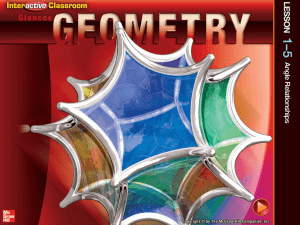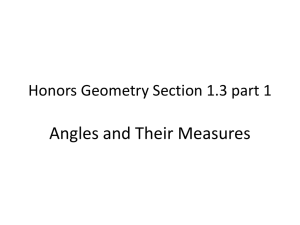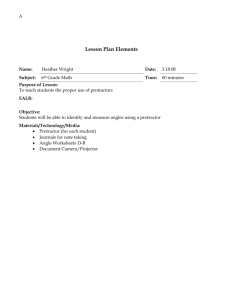Measuring Angles Section 1.3
advertisement
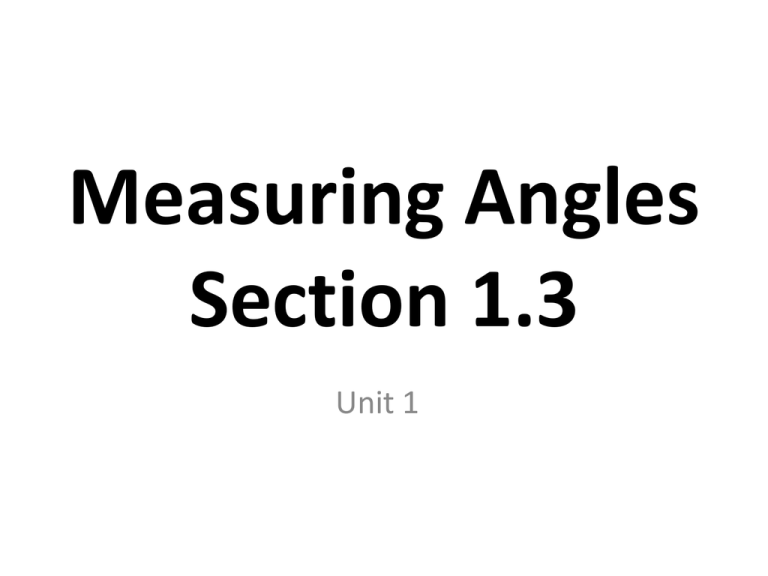
Measuring Angles Section 1.3 Unit 1 ANGLE MEASURE • Protractor: Used to measure angles. – A half-circle with coordinates from 0° to 180° How to use a protractor: • 1. Put the center of the protractor at the vertex. • 2. Align the protractor so that ray AB passes through 0 on the protractor. • 3. Read the measure of the angle (in degrees) at the point where ray AC intersects the scale on the protractor Why isn’t the measure of the angle 55 degrees instead of 125 degrees? Define: Angle Measure • Most commonly measured in degrees a 180° b 0° Definition: Measure of an Angle • Suppose that the vertex, V, of <AVB is placed on the center point of a half-circle with coordinates from 0° to 180° so that VA and VB intersect the half-circle. Let a & b be the coordinates of the intersections. • Then, the measure of the angle, written as <AVB, is a b or b a Use the protractor in the figure to find the measure of the angles indicated: • <QPR • <RPS • m<QPR + m<RPS Congruent Angles • Congruent if one can be moved onto the other so that they match exactly. • Tick marks are used to show which angles are known to be congruent • NOTE: Angles are said to match if their sides match. The length of the sides do not matter. ANGLE CONGRUENCE POSTULATE • If 2 angles have the same measure, then they are congruent. • If 2 angles are congruent, then they have the same measure. • If m<ABC = m<DEF, then ______________ • If <ABC <DEF, then ________________ ANGLE ADDITION POSTULATE • If point S is in the interior of <PQR, then m<PQS + m<SQR = m<PQR • GIVEN: EXAMPLE – m<EDG = 70° – m<FDH = 60° E F • FIND: – m<2 – m<3 – m<1 – m<4 – m<EDJ 1 D 4 G 2 3 H J SPECIAL ANGLE PAIRS • Complementary Angles: – 2 angles whose measures have a sum of 90°. – Each angle is called the complement of the other. • Supplementary Angles: – 2 angles whose measures have a sum of 180°. – Each angle is called the supplement of the other. EXAMPLE • Name a complementary angle pair and a supplementary angle pair in the figure. C D 40° 50° B A E DEFINITION: LINEAR PAIR • If the endpoint of a ray falls on a line so that two angles are formed, then the angles are known as a Linear Pair. 1 2 LINEAR PAIR PROPERTY • If two angles form a linear pair, then they are supplementary. • That means: m<1 + m<2 = 180° 1 2 EXAMPLE • GIVEN: – m<CED = 25° – <AEB and <BED form a linear pair B • FIND: C – m<BEC – m<AEB – m<AEC D A E CLASSIFICATION OF ANGLES • Classified according to their measure. • 3 different types of angles: – Right angle – Acute angle – Obtuse angle Right Angle • An angle whose measure is 90° • The symbol for a right angle is a small square placed at the vertex of the angle. Acute Angle • An angle whose measure is LESS THAN 90° Obtuse Angle • An angle whose measure is GREATER THAN 90°

